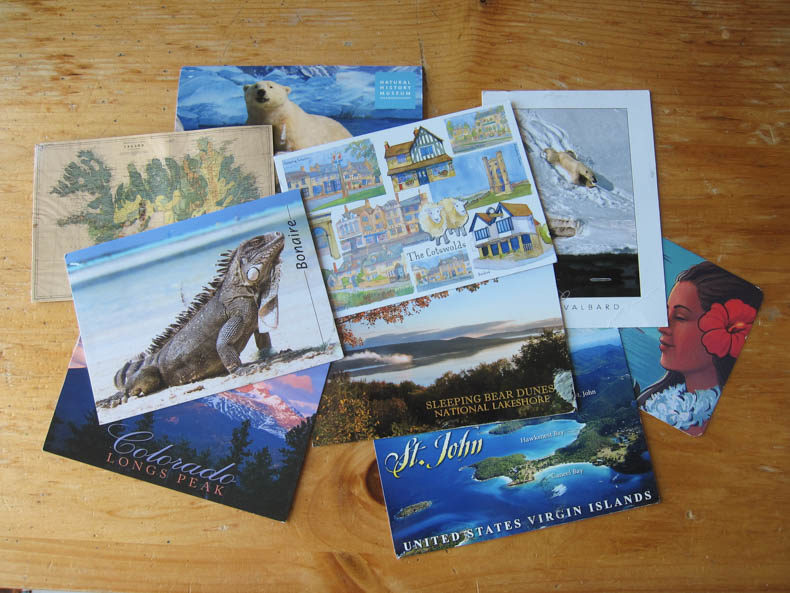
I got my primary tip on writing postcards from Garrison Keillor, an essay of his I read at least a decade and a half ago: Don’t try to write a letter. (This was in an era when many people, including me, still wrote letters.) Write a little scene. Paint a word picture for the recipient.
Writing a scene feels like showing off how good a writer you are, but I do avoid trying to squeeze a letter (“How are you? I’m fine. I’m in Hawaii. It’s nice!”) into the 60-word space. Mostly I try to be amusing.
My second postcard-writing tip came from my parents. On a visit to Romania in 1998 I commented, on a postcard, on something about Bucharest – the smell, I think? – and they alarmedly told me about a Peace Corps volunteer they heard of, in the 60s, who wrote something uncomplimentary about his host country on a postcard home and created a minor international incident.
That tip I do still follow. Be nice; anyone can read it.
First step: Keep postcard stamps in a pocket in the back of my travel sketchbook. Next step: Buy postcards. Then: Pick some people to send them to. My parents almost always get one. Sometimes one goes to Christie or Cameron and quite a few have gone to Ann. Miscellaneous other friends wander on and off of the recipient list, based on what I see and who I think might enjoy a piece of real mail. It’s like texting, but you can hold it.
A while later I’ll be over at someone’s house, see a postcard on the fridge, think, I’ve been there—oh hey, I sent that! A little piece of me, in your kitchen.
I usually don’t write the recipient’s name at the top of the message, and I’ve wondered if they think that means I wrote the postcard, then decided who should get it. My dears, no. I think of you, and then I tell you something I think you would like to know.
In foreign countries, finding stamps is part of the adventure. I go to Britain a lot, so there I know that the post office is usually a counter in the back of a store. I have also bought stamps from British gift shops a few times, but this was a mistake; they turned out to be associated with a company that must send the postcards by 19th century steamer, or perhaps by trained penguin; they take weeks and weeks to arrive. (Although they do not smell of fish, so at least the penguins have waterproof pouches.) Next time I hope I remember to find the post office.
In Saudi Arabia in 2014, I asked the women I worked with where I could find a post office, but they said, in Saudi Arabia, if you need to send something, you FedEx it. I’m way too cheap to FedEx a postcard. And a postcard in an envelope isn’t really a postcard. Nobody got a postcard from Saudi Arabia.
I personally think postcards are better if they arrive while I’m still traveling. And postcards are never sent after arriving home. The postmark has to be exotic. Not many people send me postcards, and that is fine. Just the act of writing and sending them brings me plenty of joy.
Think of it: A photo or illustration, a scrawled message, an address, and a stamp, making their way through the clerk’s hands and the whizzing machines and airplane bellies and penguin pouches and the mail carrier’s bag and into your mailbox, an epic journey by a little card, a tangible piece of somewhere else, just for you.
Rereading Christie’s post on tangible communication, I realized: deep down, I don’t believe electronic writing can be counted on. I read a lot of post-apocalyptic fiction and I assume that someday all of it will go away, all of the electronics, and no one will know how to access these digital bits and bobs. And you don’t have to look to the apocalypse; U.S.News & World Report deleted its archives from most of the years I worked there. I didn’t log into one of my email accounts for three months once, in the early 2000s, and all of my emails were deleted, including the ones from the years I’d lived in Norway and Japan.
I believe my mother has printouts of the emails I sent home in a file folder somewhere. This is a relief.
Many of my friends have written books, but maybe these postcards are my best shot at immortality. Maybe someday a piece of shiny, thick paper will be found, smushed tight in an early-21st-century midden, and a future archaeologist will learn what I thought of Svalbard. (Very cold, no polar bears.) Or maybe a friend will see an iguana from Bonaire on her fridge, and think of me, and smile.
Photo: Helen Fields
I love this meditation on postcards. I, too, am always delighted when I see a postcard I’ve sent on someone’s refrigerator door. I happen to enjoy getting cards months after they were sent and imagining the wild adventures the card had while traveling to me. And I also have no problem getting postcards sent after the writer returned home – I’m thrilled whenever someone wants to share a trip with me!
Wonder Twin powers, activate! Form of: snail mail!
I have an old and arthritic snail who could probably do with some exercise. If you’d like to let me know your snail-mail address, I’ll send himher on hisher way. diane(dot)patmore@gmail(dot)com